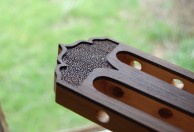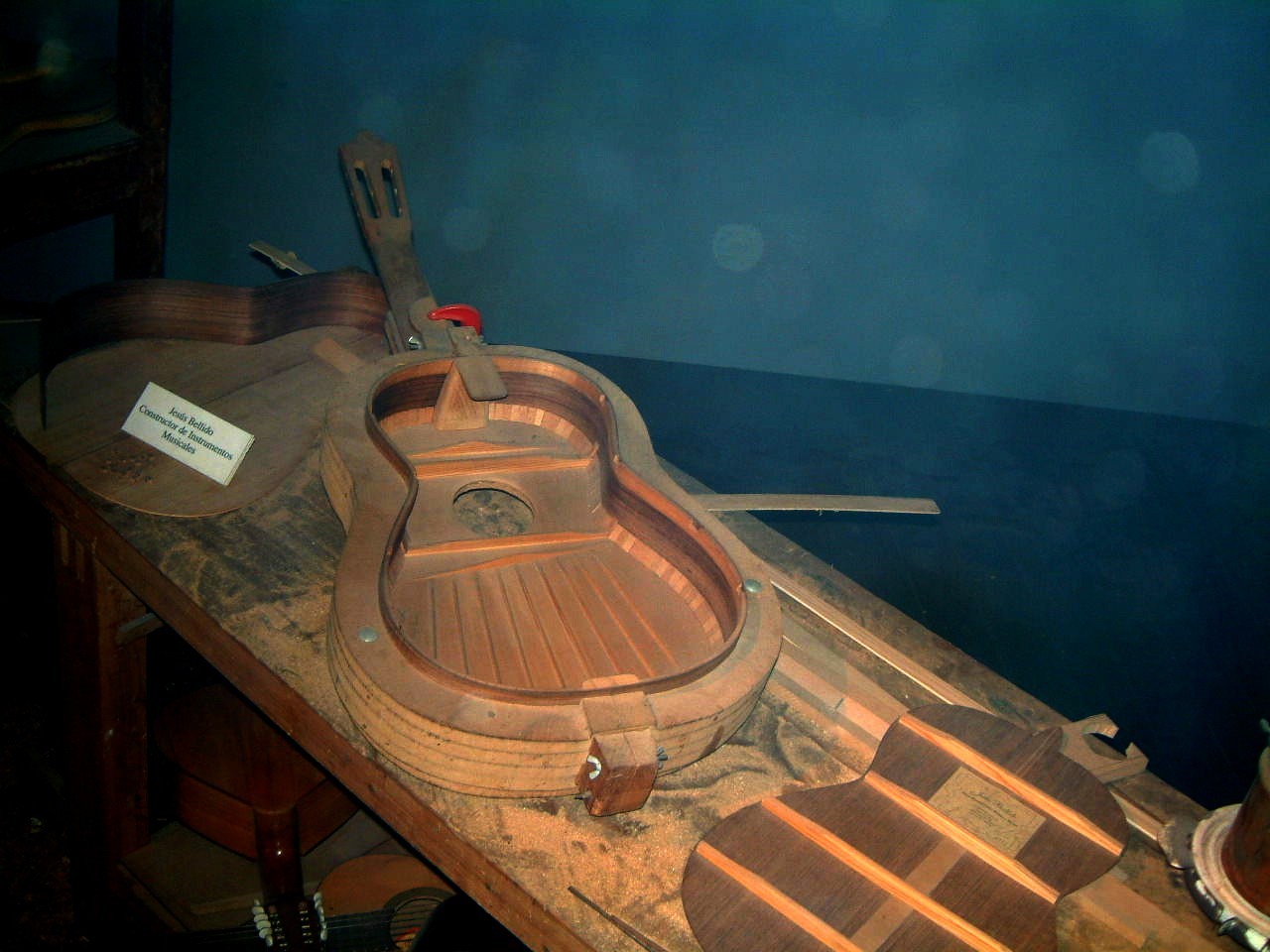Welcome to one of the most active flamenco sites on the Internet. Guests can read most posts but if you want to participate click here to register.
This site is dedicated to the memory of Paco de Lucía, Ron Mitchell, Guy Williams, Linda Elvira, Philip John Lee, Craig Eros, Ben Woods, David Serva and Tom Blackshear who went ahead of us.
We receive 12,200 visitors a month from 200 countries and 1.7 million page impressions a year. To advertise on this site please contact us.
|

|
|
Harmonic bars
|
You are logged in as Guest
|
|
Users viewing this topic: none
|
|
Login  | |
|

   
Andy Culpepper
Posts: 3023
Joined: Mar. 30 2009
From: NY, USA

|
 Harmonic bars Harmonic bars
|
|
|
Hoping to open some discussion on the theory of the large lateral braces above and below the sound hole, otherwise known as harmonic bars. Luthier-walks-into-a-harmonic-bar jokes are welcome.
My premise is that perhaps some of us just think of them as "well, let's just put something big and stiff here to tighten up the whole upper bout", without approaching them with the nuance that we would fan braces. I've certainly fallen into that camp in the past.
I think that most guitars are probably built with the harmonic bars stiffer than they need to be, structurally speaking, so is there a benefit to that in the way you build?
I'm mostly interested in the lower harmonic bar, as I've seen a few guitars with that one shaved down quite low, sometimes moreso in the center, and they seem to share a certain punchiness in the basses and lower sustain.
My first guitar, which I own, is somewhat overbuilt in the top and over the years I've used it as a good test subject for shaving braces, etc. because I know its sound quite well. The harmonic bars were about 8 x 14 mm Sitka, rounded on top so certainly some excess stiffness I think. I decided to shave about 3mm off the lower one with a small plane, and noticed a pretty apparent change for the better. I like the guitar a lot but the sound has always felt a little stiff and tense, this seemed to relax the bass register quite a bit.
I took it to dance accompaniment and it definitely seemed punchier, almost felt like I was playing a new guitar.
On my current guitars I've found ways to get those qualities with other methods so I'm hesitant to change anything, but I might experiment with shaving down my lower harmonic bars a bit.
So, how do you decide how stiff to make your harmonic bars? Do you ever fine-tune them on a finished instrument?
_____________________________
Andy Culpepper, luthier
http://www.andyculpepper.com
|
|
|
|
REPORT THIS POST AS INAPPROPRIATE |
Date May 5 2016 23:03:26
 |
|

   
Tom Blackshear
Posts: 2304
Joined: Apr. 15 2008

|
 RE: Harmonic bars (in reply to estebanana) RE: Harmonic bars (in reply to estebanana)
|
|
|
Steve,
I've been told that the Dammann Nomex top guitars do not exceed mine in volume or projection, just different in character.
What does this mean? Just that there is a difference in personal stamp for each builder.
In 1974 I started building again and my flamenco prototype included a lower harmonic bar, at the sound-hole, about 1/2" high and with fan braces about 1/4" high and 1/8" wide with what is known on the current Condes as outside low fans with high in the middle areas.
This was actually based on a 1958 Ramirez style with certain modification that added 2 outside low fans. It was a fire cracker with a 3/32" thick top, and I revived many stores orders for it. And as you know I have been doing fine tuning for the past 30 + years, much longer than Dammann.
So why add this information but just to say that much of this modern style has already been done, to some extent, before Jose Romanillos and Matthias Dammann started building. I built my first guitar in 1958, when David Spinks (Jose Rubio) and I were playing flamenco and building. And I might add that Eugene Clark was giving Mr. Rubio pointers on how to build guitars at that time in history.
So the truth be told, there is not hardly anything new under the sun that hasn't been tried before.
Note: Romanillos and Dammann are certainly well respected builders and they provide interest in this art.
And Steve, I agree that everything in the top has to do with weight and thickness, even in compliance with wood to wood ratio between fan braces and top thickness.
_____________________________
Tom Blackshear Guitar maker
|
|
|
|
REPORT THIS POST AS INAPPROPRIATE |
Date May 7 2016 15:33:17
 |
|

   
estebanana
Posts: 9351
Joined: Oct. 16 2009

|
 RE: Harmonic bars (in reply to Tom Blackshear) RE: Harmonic bars (in reply to Tom Blackshear)
|
|
|
quote:
Steve,
I've been told that the Dammann Nomex top guitars do not exceed mine in volume or projection, just different in character.
What does this mean? Just that there is a difference in personal stamp for each builder.
In 1974 I started building again and my flamenco prototype included a lower harmonic bar, at the sound-hole, about 1/2" high and with fan braces about 1/4" high and 1/8" wide with what is known on the current Condes as outside low fans with high in the middle areas.
This was actually based on a 1958 Ramirez style with certain modification that added 2 outside low fans. It was a fire cracker with a 3/32" thick top, and I revived many stores orders for it. And as you know I have been doing fine tuning for the past 30 + years, much longer than Dammann.
So why add this information but just to say that much of this modern style has already been done, to some extent, before Jose Romanillos and Matthias Dammann started building. I built my first guitar in 1958, when David Spinks (Jose Rubio) and I were playing flamenco and building. And I might add that Eugene Clark was giving Mr. Rubio pointers on how to build guitars at that time in history.
So the truth be told, there is not hardly anything new under the sun that hasn't been tried before.
Note: Romanillos and Dammann are certainly well respected builders and they provide interest in this art.
And Steve, I agree that everything in the top has to do with weight and thickness, even in compliance with wood to wood ratio between fan braces and top thickness.
_____________________________
Tom,
Both my guitar teacher and guitar making teacher were fellows of David Rubio's in NY. David Serva and Mr. Spinks were playing guitar duets together and Eugene was one of the people on the NY scene who did show a few things to Rubio the builder. I've heard the narrative from both of them and a few others who were in that crowd. It would be interesting to hear your version. I've been told by a dealer it was not possible Clark taught Rubio anything about guitar making and that he learned from someone else, but I have pretty good reason to understand a different narrative.
I'm not super interested in Dammann/ Wagner style work. I met Randy Reynolds, one of the best double top makers in the US , and probably in the world by now, in 2003. He offered to teach me to make DT's , in retrospect I should have taken him up on it, but I've never seen them as a necessary to understand or make great flamenco guitars. I'm still reeling from playing Steve Kahn's 1924 Santos and I figure you could spend you life just trying to accomplish that as a guitar maker.
Under Gene's influence, I guess he made a pretty big impact on my basic understanding, and in some ways I've had to outgrow retool my thinking because he made such an imprint on me; that is to say one real basic thing he brought home is that the guitar is not a LOUD instrument, it's an instrument with voice. When you stress the voice, the human voice, it breaks all apart. He said the guitar does the same thing, if you stress it is ceases to be a voice, it becomes a shout or a yell. We talked a lot about making guitars that speak like great actors, not scream.
We had a lot of these silly conversations, that was great fun, and there are some truths, I think. I really need to see him, or send Gene a guitar so he can play it and I can finally get my 'diploma'.

_____________________________
https://www.stephenfaulkguitars.com
|
|
|
|
REPORT THIS POST AS INAPPROPRIATE |
Date May 8 2016 8:11:42
 |
|

   
Tom Blackshear
Posts: 2304
Joined: Apr. 15 2008

|
 RE: Harmonic bars (in reply to estebanana) RE: Harmonic bars (in reply to estebanana)
|
|
|
quote:
Under Gene's influence, I guess he made a pretty big impact on my basic understanding, and in some ways I've had to outgrow retool my thinking because he made such an imprint on me; that is to say one real basic thing he brought home is that the guitar is not a LOUD instrument, it's an instrument with voice. When you stress the voice, the human voice, it breaks all apart. He said the guitar does the same thing, if you stress it is ceases to be a voice, it becomes a shout or a yell. We talked a lot about making guitars that speak like great actors, not scream.
My association with Eugene was over the telephone in the years we talked together. He basically put into words what I had always felt through personal intuition about the guitar. As Brune put it, I innately understood how a guitar worked. But this was not so in-born, as I understand it, but a love that overcame certain problematic disagreements to help me blend with what the guitar wanted to be. The guitar was and still is a part of me in this regard.
So my search brought me to the Miguel Rodriguez guitars back in the 1970's that characteristically were loud but had certain inter-dimensional voicing that could be guided by the master builder to be raw or sweet in its dynamic range. But Eugene is right about a guitar when it comes to having both loudness and sweetness; you have to sacrifice some of its loudness to get the sweetness. Otherwise you wind up with a traditional style guitar that is not well balanced.
To get the vowel tone, like a human voice, you have to bend the sound with fine tuning, as I understand it, and this is accomplished many different ways. But I like my techniques as they are humanly possible and play well with those, like me, that have a simple mind for stretching the imagination:-)
_____________________________
Tom Blackshear Guitar maker
|
|
|
|
REPORT THIS POST AS INAPPROPRIATE |
Date May 8 2016 11:45:05
 |
|

   
Richard Jernigan
Posts: 3430
Joined: Jan. 20 2004
From: Austin, Texas USA

|
 RE: Harmonic bars (in reply to estebanana) RE: Harmonic bars (in reply to estebanana)
|
|
|
When I was at Arturo Huipe's shop in Paracho ten years ago there were a couple of dozen guitars hanging in the humidity controlled room, most of them unfinished. We talked and I played occasionally for an hour and a half.
He handed me a guitar with Oregon myrtle/California laurel back and sides. I believe the top was spruce, but I am no longer sure. I played some flamenco with rasgueados. It responded crisply, but not in an expected way. Huipe smiled and said, "It's a Fleta."
I'm sure I looked puzzled so he explained, "I wondered what a flamenco made by Fleta would sound like, so I made one with [Spanish name of wood] back and sides and a little bit lighter bracing." It was interesting, but not really flamenco, at least the way I played it.
I ended up buying a cedar/cocobolo "Fleta" model from him. It was the second best guitar I played in Paracho that day, and I liked Huipe. The best was the small Torres model (632mm) that Abel Garcia made for his daughter.
I plan to give the "Fleta" model to the Austin Classical Guitar Society for them to give to some student in one of the secondary school guitar programs. It's a good guitar, but not quite in the same class as my two best classicals, one of which is the spruce/Brazilian I ordered from Abel Garcia the next day.
RNJ
|
|
|
|
REPORT THIS POST AS INAPPROPRIATE |
Date May 10 2016 19:31:59
 |
|
 New Messages New Messages |
 No New Messages No New Messages |
 Hot Topic w/ New Messages Hot Topic w/ New Messages |
 Hot Topic w/o New Messages Hot Topic w/o New Messages |
 Locked w/ New Messages Locked w/ New Messages |
 Locked w/o New Messages Locked w/o New Messages |
|
 Post New Thread
Post New Thread
 Reply to Message
Reply to Message
 Post New Poll
Post New Poll
 Submit Vote
Submit Vote
 Delete My Own Post
Delete My Own Post
 Delete My Own Thread
Delete My Own Thread
 Rate Posts
Rate Posts
|
|
|
Forum Software powered by ASP Playground Advanced Edition 2.0.5
Copyright © 2000 - 2003 ASPPlayground.NET |
0.09375 secs.
|


 Printable Version
Printable Version














 New Messages
New Messages No New Messages
No New Messages Hot Topic w/ New Messages
Hot Topic w/ New Messages Hot Topic w/o New Messages
Hot Topic w/o New Messages Locked w/ New Messages
Locked w/ New Messages Locked w/o New Messages
Locked w/o New Messages Post New Thread
Post New Thread